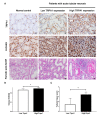Renal Tubular TRPA1 as a Risk Factor for Recovery of Renal Function from Acute Tubular Necrosis
- PMID: 31835897
- PMCID: PMC6947213
- DOI: 10.3390/jcm8122187
Renal Tubular TRPA1 as a Risk Factor for Recovery of Renal Function from Acute Tubular Necrosis
Abstract
Background: Transient receptor potential ankyrin 1 (TRPA1), a redox-sensing Ca2+-influx channel, serves as a gatekeeper for inflammation. However, the role of TRPA1 in kidney injury remains elusive.
Methods: The retrospective cohort study recruited 46 adult patients with acute kidney injury (AKI) and biopsy-proven acute tubular necrosis (ATN) and followed them up for more than three months. The subjects were divided into high- and low-renal-tubular-TRPA1-expression groups for the comparison of the total recovery of renal function and mortality within three months. The significance of TRPA1 in patient prognosis was evaluated using Kaplan-Meier curves and logistic regression analysis.
Results: Of the 46 adult AKI patients with ATN, 12 totally recovered renal function. The expression level of tubular TRPA1 was detected by quantitative analysis of the immunohistochemistry of biopsy specimens from ATN patients. The AKI patients with high tubular TRPA1 expression showed a high incidence of nontotal renal function recovery than those with low tubular TRPA1 expression (OR = 7.14; 95%CI 1.35-37.75; p = 0.02). High TRPA1 expression was independently associated with nontotal recovery of renal function (adjusted OR = 6.86; 95%CI 1.26-37.27; p = 0.03).
Conclusion: High tubular TRPA1 expression was associated with the nontotal recovery of renal function. Further mechanistic studies are warranted.
Keywords: TRPA1; acute kidney injury; acute tubular necrosis; recovery of renal function.
Conflict of interest statement
The authors declare no competing financial interests.
Figures




Similar articles
-
Role of TRPA1 in Tissue Damage and Kidney Disease.Int J Mol Sci. 2021 Mar 26;22(7):3415. doi: 10.3390/ijms22073415. Int J Mol Sci. 2021. PMID: 33810314 Free PMC article. Review.
-
Tubular Peroxiredoxin 3 as a Predictor of Renal Recovery from Acute Tubular Necrosis in Patients with Chronic Kidney Disease.Sci Rep. 2017 Feb 27;7:43589. doi: 10.1038/srep43589. Sci Rep. 2017. PMID: 28240739 Free PMC article.
-
Pathological Features of Recovery or Progression in Acute Tubular Necrosis: Single Centre Study.Saudi J Kidney Dis Transpl. 2022 Feb;33(Supplement):S12-S17. doi: 10.4103/1319-2442.374378. Saudi J Kidney Dis Transpl. 2022. PMID: 37102520
-
Survey of acute kidney injury and related risk factors of mortality in hospitalized patients in a third-level urban hospital of Shanghai.Blood Purif. 2014;38(2):140-8. doi: 10.1159/000366127. Epub 2014 Nov 27. Blood Purif. 2014. PMID: 25471326
-
Renal histopathology of prolonged acute kidney injury in HELLP syndrome: a case series and literature review.Int Urol Nephrol. 2019 Jun;51(6):987-994. doi: 10.1007/s11255-019-02135-z. Epub 2019 Apr 15. Int Urol Nephrol. 2019. PMID: 30989562 Review.
Cited by
-
Diagnostics, Risk Factors, Treatment and Outcomes of Acute Kidney Injury in a New Paradigm.J Clin Med. 2020 Apr 13;9(4):1104. doi: 10.3390/jcm9041104. J Clin Med. 2020. PMID: 32294894 Free PMC article.
-
Inflammation-the role of TRPA1 channel.Front Physiol. 2023 Feb 16;14:1093925. doi: 10.3389/fphys.2023.1093925. eCollection 2023. Front Physiol. 2023. PMID: 36875034 Free PMC article. Review.
-
Interleukin 1 beta-induced calcium signaling via TRPA1 channels promotes mitogen-activated protein kinase-dependent mesangial cell proliferation.FASEB J. 2021 Jul;35(7):e21729. doi: 10.1096/fj.202100367R. FASEB J. 2021. PMID: 34143493 Free PMC article.
-
Function and therapeutic potential of transient receptor potential ankyrin 1 in fibrosis.Front Pharmacol. 2022 Oct 6;13:1014041. doi: 10.3389/fphar.2022.1014041. eCollection 2022. Front Pharmacol. 2022. PMID: 36278189 Free PMC article. Review.
-
Role of TRPA1 in Tissue Damage and Kidney Disease.Int J Mol Sci. 2021 Mar 26;22(7):3415. doi: 10.3390/ijms22073415. Int J Mol Sci. 2021. PMID: 33810314 Free PMC article. Review.
References
Grants and funding
LinkOut - more resources
Full Text Sources
Miscellaneous

